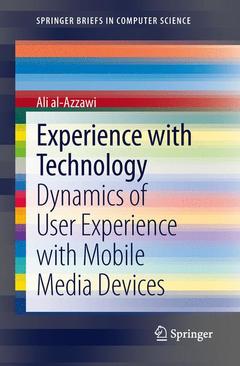Description
Experience with Technology, 2014
Dynamics of User Experience with Mobile Media Devices
SpringerBriefs in Computer Science Series
Author: al-Azzawi Ali
Language: English
142 p. · 15.5x23.5 cm · Paperback
Description
/li>Contents
/li>Comment
/li>
With a focus on gaining an empirically derived understanding of the underlying psychological dimensions and processes behind people?s experiences with technology, this book contributes to the debate of user experience (UX) within several disciplines, including HCI, design and marketing. It analyses UX dynamics at various time scales, and explores the very nature of time and meaning in the context of UX.
Experience with Technology uses personal construct theory (PCT) as a theoretical and methodological starting point to this project. Major case-studies are described that examine people?s experiences with mobile media devices. The results show a group of super-ordinate constructs that, upon interaction, undergo a change in the way they vary and relate to each other, as well as the development of a high reliability UX-Scale.
The book concludes by proposing the ICE (Interaction,Construction, and Evaluation) model of UX that consolidates its findings into a workable framework of UX. The proposed framework will be of particular use to designers and practitioners, and forms an empirically grounded starting point for further research.
Foreword by David Frohlich and Margaret Wilson.- Preface.- Introduction.- Theories of Experience.- Measuring Experience.- Construct Dynamics: Interaction.- Construct Dynamics: Consumption.- ICE: A Model of Experience with Technology.- Conclusions.- Appendices.




